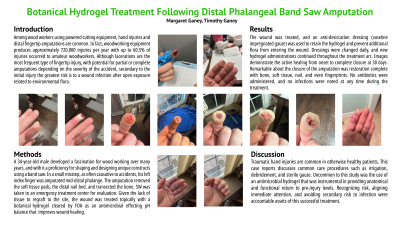Case Series/Study
(CS-050) Botanical Hydrogel Treatment Following Distal Phalangeal Band Saw Amputation

Among wood workers using powered cutting equipment, hand injuries and distal fingertip amputations are common. In fact, woodworking equipment produces approximately 720,000 injuries per year with up to 60.5% of injuries occurred to amateur woodworkers. Although lacerations are the most frequent type of fingertip injury, with potential for partial or complete amputations depending on the severity of the accident, secondary to the initial injury the greatest risk is to a wound infection after open exposure related to environmental flora.
Methods:
A 34-year-old male developed a fascination for wood working over many years, and with it a proficiency for shaping and designing unique constructs using a band saw. In a small misstep, as often causative to accidents, his left index finger was amputated mid-distal phalange. The amputation removed the soft tissue pads, the distal nail bed, and transected the bone. SW was taken to an emergency treatment center for evaluation. Given the lack of tissue to regraft to the site, the wound was treated topically with a botanical hydrogel cleared by FDA as an antimicrobial, effects pH balancing and improves wound healing.
Results:
The wound was treated, and an anti-desiccation dressing (vaseline impregnated gauze) was used to retain the hydrogel and prevent additional flora from entering the wound. Dressings were changed daily, and new hydrogel administrations continued throughout the treatment arc. Images demonstrate the active healing from onset to complete closure at 30 days. Remarkable about the closure of the amputation was restoration complete with bone, soft tissue, nail, and even fingerprints. No antibiotics were administered, and no infections were noted at any time during the treatment.
Discussion:
Traumatic hand injuries are common in otherwise healthy patients. This case reports discusses common care procedures such as irrigation, debridement, and sterile gauze. Uncommon to this study was the use of an antimicrobial hydrogel that was instrumental in providing anatomical and functional return to pre-injury levels. Recognizing risk, aligning immediate attention, and avoiding secondary risk to infection were accountable assets of this successful treatment.

.jpg)